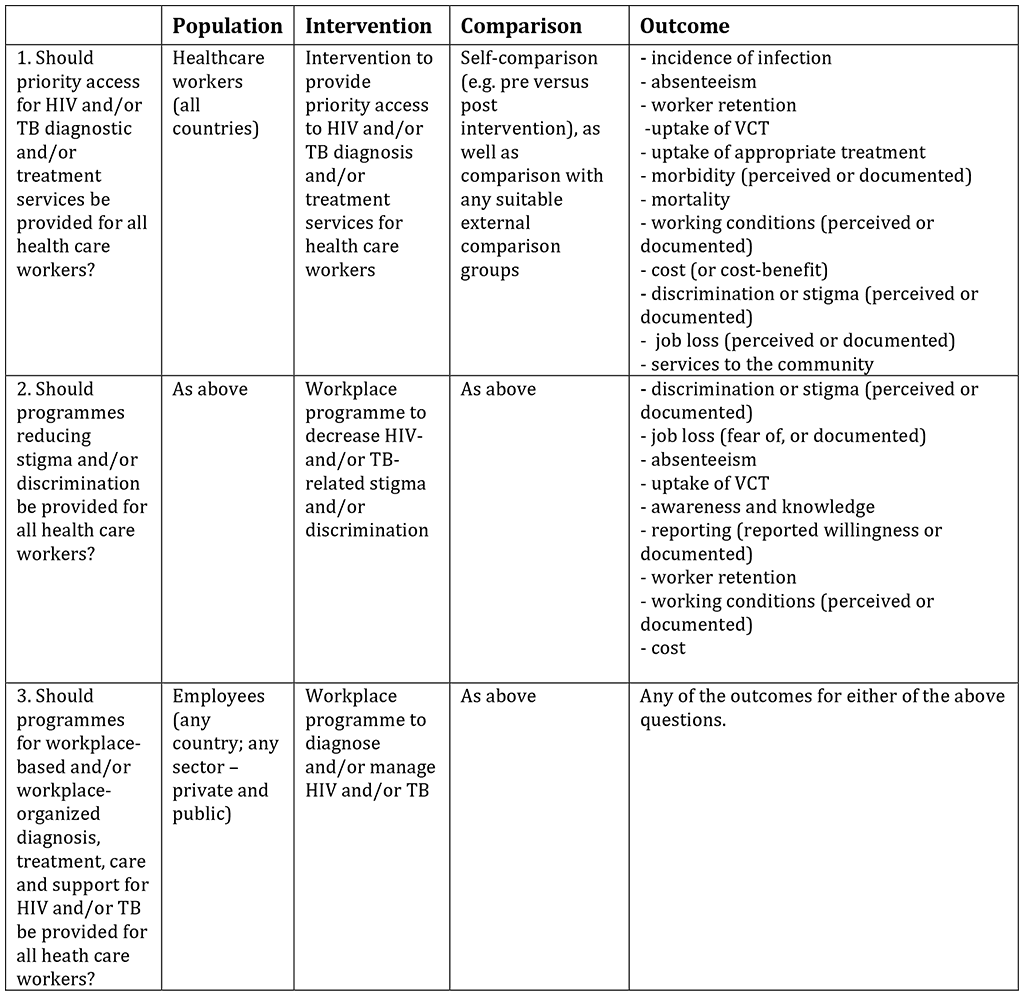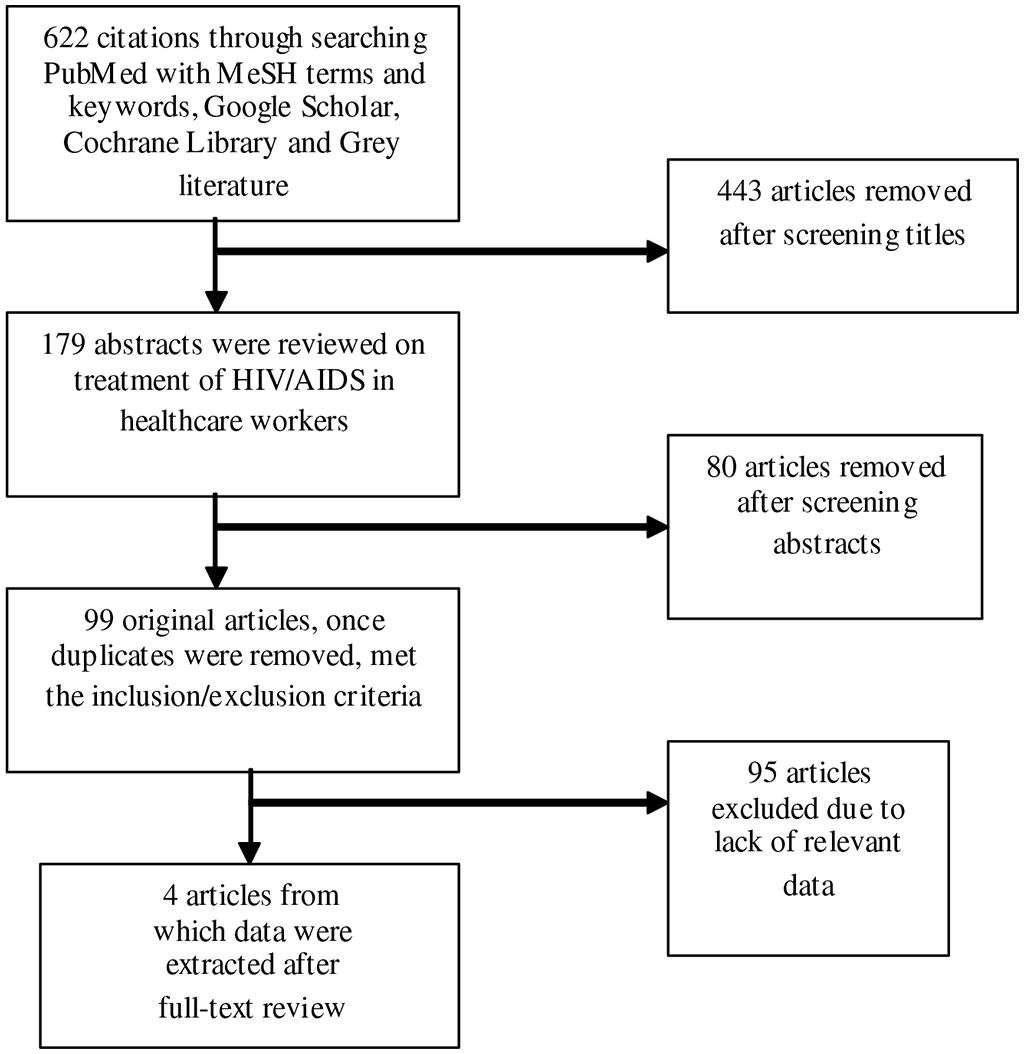كتاب روابط اجتياز لـ 1266
The Guideline Group, after a preliminary review of existing guidelines, as well as the results of the Five Country Study, the multi-country survey, and the preliminary literature review, identified three questions for a Cochrane-style systematic review, as noted above. Evidence regarding the extent of the problem of HIV and TB in healthcare workers, various aspects of determinants of these diseases and the morbidity and mortality that ensues, efficacy of clinical treatment regimens, effectiveness of specific workplace prevention measures, and other matters that have already been the subject of international guidelines were not included in this component of the Systematic Review. The questions formulated are listed in Table 1 below, using the framework in the WHO Handbook for Development of Guidelines, namely the Population, Intervention, Comparison, and Outcome (PICO framework). This Cochrane-Style Systematic Review focused on evaluating the evidence for the effectiveness of workplace interventions
A comprehensive search methodology was employed based on the guidelines of the WHO Handbook for Guideline Development. The general challenges encountered in conducting systematic reviews of health promotion and public health intervention have been well documented (Shepperd 2009, Eccles 2009, Lavis 2009, Jackson 2005). Search strategies were conducted to maximize the inclusion of as many relevant studies as possible, while still observing appropriate and reproducible search strategies. Electronic searches of PubMed, Google Scholar, Cochrane Collaboration Library, and relevant websites of trade unions and other organizations were conducted, as well as searches of references from articles found in this search strategy, and articles provided by GG members that met the selection criteria.
The objective of this component of the Systematic Review was to evaluate the evidence regarding interventions to provide priority access to HIV and/or TB diagnostic and/or treatment services to health workers as well as to other workforces, as well as programmes to reduce stigma within the health workforce and/or discrimination against health workers. Outcomes of interest included incidence of infection, absenteeism, worker retention, uptake of VCT, uptake of appropriate treatment, morbidity, mortality, and improved working conditions (perceived or documented), as well as discrimination or stigma (perceived or documented), job loss (fear of, or documented), services to the community and cost. The GG decided NOT to prioritize the outcome measures but to consider ANY outcome measures found in studies, given that different parties amongst the target audience for whom these guidelines are being developed have different priority outcomes of interest. To be included in this component of the Systematic Review, outcome measures had to include at least one of the outcome measures. Positive as well as negative outcomes were sought, including whether the intervention led to increased stigma and/or, discrimination (perceived or documented); increased job loss (perceived or documented); decreased services to the community; or high cost. Studies assessing any of these outcomes relating to a workforce intervention, conducted since 1984, and available electronically by August 1, 2009, were included. Given that HIV was only discovered around this time, and given that knowledge regarding TB and TB control programmes has changed considerably since the re-emergence of TB, and the emergence of multiple resistant strains, information obtained in studies preceding 1984 did not seem warranted. (Items published since August 1, 2009 were excluded from the Systematic Review, to maintain strict adherence with a priori protocol. However items provided to the consultants after that date, were included in the realist review, as discussed below.)
A minimum of two reviewers independently extracted data and assessed inclusion criteria; studies were also profiled and quality assessed by a minimum of two reviewers including the senior reviewer on the team. No new statistical analyses were conducted for this review. As shown in Table 1 below, studies in which the target population for the intervention were health workers from any country were included in the search with respect to questions on priority access to diagnosis and treatment, however findings from workplace intervention studies in any sector were included for the question evaluating the effectiveness of workplace interventions for HIV and TB.
For workplace interventions, studies with the most comprehensive reporting of the nature of the intervention and details of the methodology and results, are not necessarily the most informative for ascertaining determinants of success of interventions. (Egan 2009). As such, qualitative aspects of the 11 studies were also reviewed, adding one additional review article published after the cut-off date, related to stigma and discrimination (Nyblade 2009), in view of the absence of studies that were identified using the standard Cochrane-type approach.
Table 1: PICO selection criteria for questions designated for systematic evidence review

*Exclusion criteria: failure to meet the selection criteria. For example, studies that were baseline assessments to document the need for or prepare interventions were excluded, as were commentaries and editorials, as were patient intervention studies (rather than interventions that targeted the workforce).
The results of the review are included in the systematic review.
Figure 2: Search strategy for PICO #1

Similar search strategies were used for PICO 2 (196 citations, in the end 0 articles remaining from which data were extracted) and PICO 3 (368 citations, in the end 7 articles used from which data were extracted).

 تعليق
تعليق